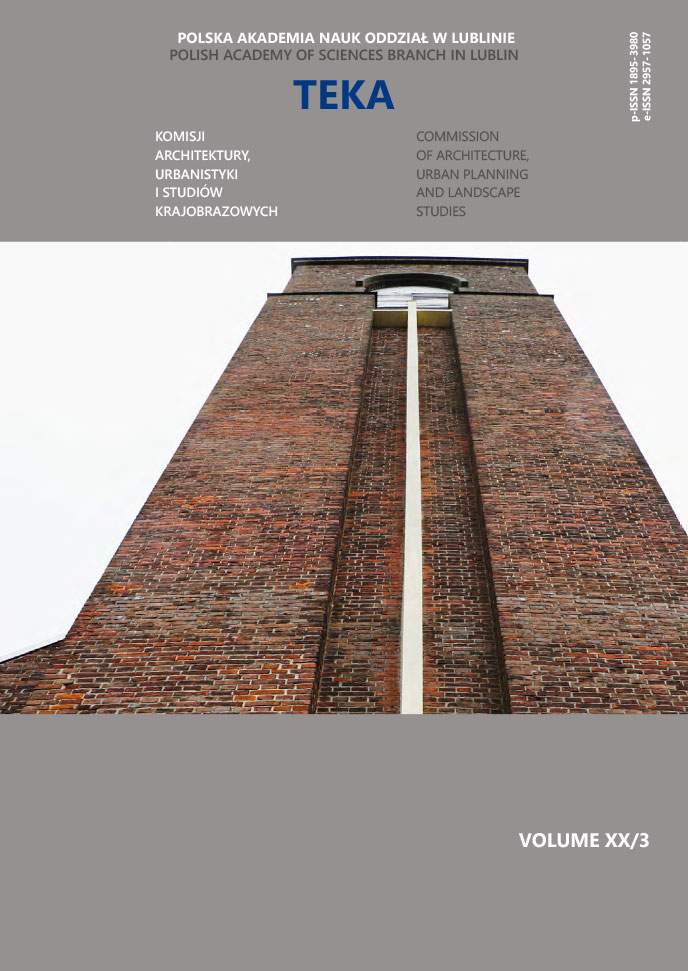Comparative method with the use of laser scanning as a starting point for the assessment of the state of preservation of the face of the walls in the Kłodzko Fortress
Piotr Gleń
p.glen@pollub.plFaculty of Civil Engineering and Architecture, Lublin University of Technology (Poland)
https://orcid.org/0000-0002-2975-408X
Karol Krupa
Faculty of Civil Engineering and Architecture, Lublin University of Technology (Poland)
https://orcid.org/0000-0002-7313-4080
Abstract
This article presents architectural studies of the state of preservation of the face of the wall of the Kłodzko Fortress on the basis of the surveying works performed since 2016. These works include measurement of the entire fortress with the use of laser scanning. The analysis was carried out on the face of the wall, gradually degrading due to external factors and incorrect protection of the masonry. For detailed analysis, clouds of points from the period of 2 years (2017-2018) were used, taking into account the discussed northern part of the wall of the Great Tenaille (Wielkie Kleszcze). The paper explains the importance of the surveying process for the conservation works aiming at protection of the historical tissue from further degradation.
Keywords:
fortress, Kłodzko, survey, fortification, 3D scanning, cloud of pointsReferences
Gleń P., Krupa K., Comparative analysis of the inventory process using manual measurements and laser scanning, Budownictwo i Architektura 18(2) (2019)21−30 DOI: 10.35784/bud-arch.552.
DOI: https://doi.org/10.35784/bud-arch.552
Google Scholar
Rzonca A., Współczesne metody kompleksowej inwentaryzacji zabytków na przykładzie kościoła w Michalicach, w: Archiwum Fotorgametrii, Kartografii i Teledetekcji, Vol. 14, 2004.
Google Scholar
Małachowicz E., Nowożytne fortyfikacje Śląska europejskim dziedzictwem kultury.
Google Scholar
Jędrysiak T., Mikos von Rohrscheidt A., Militarna turystyka kulturowa, PWE, 2011.
Google Scholar
https://www.dawnekłodzko.pl, accessed: 09.06.2020.
Google Scholar
Decision KL-V-1/61/30 of 13th May 1960 about the entry to the Register of the Historic Monuments.
Google Scholar
Małachowicz M., Twierdze Śląskie – 20 lat później, Fortyfikacje nowożytne w Polsce – badania, realizacje, projekty. Zagospodarowanie do współczesnych funkcji.
Google Scholar
Mitka B., Usability of terrestrial laser scanners for the process of documentation and modeling of historical objects, in: Archiwum Fotogrametrii, Kartografii i Teledetekcji, Vol. 17b, 2007.
Google Scholar
Remondino F., Heritage Recording and 3D Modeling with Photogrammetry and 3D Scanning, in: Remote Sensing 2011.
DOI: https://doi.org/10.3390/rs3061104
Google Scholar
D Laser Scanning of Heritage in: Historic England.
Google Scholar
Gleń P., Krupa K., The use of secondary build-up in historical fabric based on the donjon of Kłodzko Fortress in: E3S Web of Conferences, 2018, vol. 49, DOI: https://doi.org/10.1051/e3sconf/20184900031.
DOI: https://doi.org/10.1051/e3sconf/20184900031
Google Scholar
Mikos v Rohrscheidt A., Turystyka Kulturowa, http://turystykakulturowa.org/, No. 2/2009.
Google Scholar
Authors
Piotr Gleńp.glen@pollub.pl
Faculty of Civil Engineering and Architecture, Lublin University of Technology Poland
https://orcid.org/0000-0002-2975-408X
Authors
Karol KrupaFaculty of Civil Engineering and Architecture, Lublin University of Technology Poland
https://orcid.org/0000-0002-7313-4080
Statistics
Abstract views: 180PDF downloads: 150
License

This work is licensed under a Creative Commons Attribution-ShareAlike 4.0 International License.




